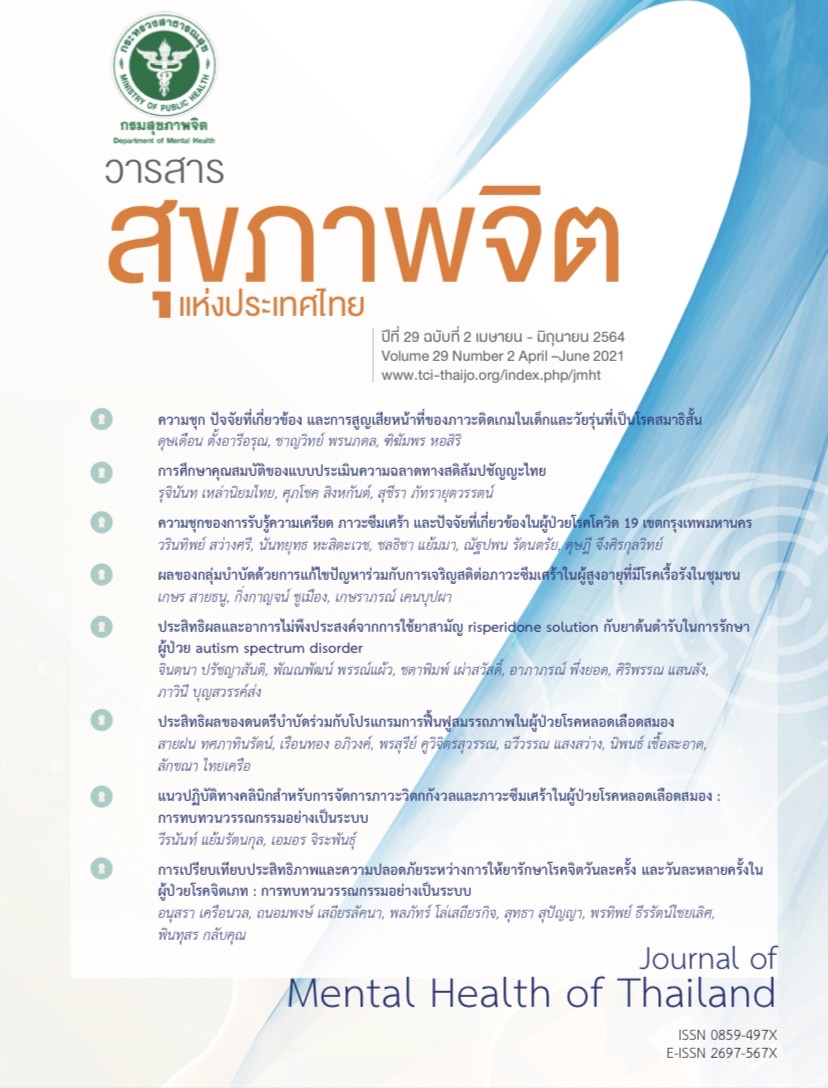ความชุก ปัจจัยที่เกี่ยวข้อง และการสูญเสียหน้าที่ของภาวะติดเกมในเด็กและวัยรุ่นที่เป็นโรคสมาธิสั้น
คำสำคัญ:
การสูญเสียหน้าที่, ความชุก, ภาวะติดเกม, โรคสมาธิสั้นบทคัดย่อ
วัตถุประสงค์ : เพื่อศึกษาความชุกของภาวะติดเกมในเด็กที่ป่วยเป็นโรคสมาธิสั้น รวมถึงปัจจัยที่เกี่ยวข้อง และการสูญเสียหน้าที่จากโรคสมาธิสั้น
วิธีการ : เป็นการศึกษาเชิงพรรณนาแบบตัดขวางในเด็กที่ป่วยเป็นโรคสมาธิสั้นอายุระหว่าง 6 ถึง 18 ปี จำนวน 455 คน ใช้แบบทดสอบการติดเกม (game addiction screening test; GAST) เพื่อคัดกรองเด็กที่มีความเสี่ยงติดเกม และยืนยันการวินิจฉัยภาวะติดเกม (internet gaming disorder; IGD) ด้วยการสัมภาษณ์ทางจิตเวชตามเกณฑ์วินิจฉัยโรค DSM-5 ศึกษาการสูญเสียหน้าที่จากโรคสมาธิสั้น โดยใช้แบบประเมินความบกพร่องทางหน้าที่ในเด็กและวัยรุ่นที่ป่วยเป็นโรคสมาธิสั้น (Weiss functional impairment rating scale: WFIRS) วิเคราะห์ข้อมูลโดยใช้สถิติเชิงพรรณนา, t-test และ chi-square test
ผล : เด็กที่เป็นโรคสมาธิสั้นและผู้ปกครองตอบรับเข้าร่วมวิจัยจำนวน 320 คู่ (ร้อยละ 70.3) จากการคัดกรองพบมีความเสี่ยงติดเกมจำนวน 70 คน (ร้อยละ 22.1) และได้รับการวินิจฉัยภาวะติดเกม 25 คน (ร้อยละ 8.3) ปัจจัยที่สัมพันธ์กับภาวะติดเกม ได้แก่ ระยะเวลาที่เล่นเกม (p < .05) และการเล่นเกมที่มีความรุนแรง (p < .05) โดยพบว่าเด็กที่ป่วยเป็นโรคสมาธิสั้นที่มีภาวะติดเกมมีคะแนนการสูญเสียหน้าที่จากโรคสมาธิสั้นทั้งจากแบบประเมินตัวเองและประเมินโดยผู้ปกครองสูงกว่ากลุ่มที่ไม่ติดเกม (p < .05)
สรุป : ภาวะติดเกมเป็นโรคร่วมที่พบได้บ่อยในเด็กที่เป็นโรคสมาธิสั้น และส่งผลต่อการสูญเสียหน้าที่จากโรคสมาธิสั้น การประเมินและติดตามภาวะติดเกมในเด็กที่ป่วยเป็นโรคสมาธิสั้นเป็นระยะ จะช่วยให้เด็กได้รับการช่วยเหลืออย่างเหมาะสม
Downloads
เอกสารอ้างอิง
Dreier M, Wölfling K, Duven E, Giralt S, Beutel ME, Müller KW. Free-to-play: about addicted whales, at risk dolphins and healthy minnows, monetarization design and internet gaming disorder. Addict Behav. 2017;64:328-33. doi:10.1016/j.addbeh.2016.03.008.
Gentile DA, Bailey K, Bavelier D, Brockmyer JF, Cash H, Coyne SM, et al. Internet gaming disorder in children and adolescents. Pediatrics. 2017;140 (Suppl 2):S81-5. doi:10.1542/peds.2016-1758H.
Paulus FW, Ohmann S, von Gontard A, Popow C. Internet gaming disorder in children and adolescents: a systematic review. Dev Med Child Neurol. 2018;60(7):645-59. doi:10.1111/dmcn.13754.
VAN Rooij AJ, Kuss DJ, Griffiths MD, Shorter GW, Schoenmakers MT, VAN DE Mheen D. The (co-)occurrence of problematic video gaming, substance use, and psychosocial problems in adolescents. J Behav Addict. 2014;3(3):157-65. doi:10.1556/JBA.3.2014.013.
Fam JY. Prevalence of internet gaming disorder in adolescents: a meta-analysis across three decades. Scand J Psychol. 2018;59(5):524-31. doi:10.1111/sjop.12459.
Chupradit S, Kaewmamuang N, Kienngam N, Chupradit P. Prevalence and correlates between game addiction and stress of adolescents in Chiang Mai, Thailand. Indian J Public Health Res Dev. 2019;10(8):1091. doi:10.5958/0976-5506.2019.02042.4.
Kietglaiwansiri T, Chonchaiya W. Pattern of video game use in children with attention-deficit-hyperactivity disorder and typical development. Pediatr Int. 2018;60(6):523-8. doi:10.1111/ped.13564.
วรุณา กลกิจโกวินท์, ชัยพร วิศิษฎ์พงศ์อารีย์, พิสาส์น เตชะเกษม, ชาญวิทย์ พรนภดล, บุษบา ศุภวัฒน์ธนบดี. การติดเกมคอมพิวเตอร์ ปัจจัยเสี่ยงและปัจจัยป้องกันของเด็กนักเรียน ในเขตดุสิต กรุงเทพมหานคร [Computer game addiction: risk and protective factors in students in Dusit District, Bangkok]. วชิรเวชสาร. 2558;59(3):1-14.
Taechoyotin P, Tongrod P, Thaweerungruangkul T, Towattananon N, Teekapakvisit P, Aksornpusitpong C, et al. Prevalence and associated factors of internet gaming disorder among secondary school students in rural community, Thailand: a cross-sectional study. BMC Res Notes. 2020;13(1):11. doi:10.1186/s13104-019-4862-3.
Feng W, Ramo DE, Chan SR, Bourgeois JA. Internet gaming disorder: trends in prevalence 1998-2016. Addict Behav. 2017;75:17-24. doi:10.1016/j.addbeh.2017.06.010.
Petry NM, Rehbein F, Ko CH, O'Brien CP. Internet gaming disorder in the DSM-5. Curr Psychiatry Rep. 2015;17(9):72. doi:10.1007/s11920-015-0610-0.
American Psychiatric Association. Diagnostic and statistical manual of mental disorders (DSM-5). 5th ed. Washington, DC: American Psychiatric Publishing; 2013.
World Health Organization. The ICD-11 classification of mental and behavioral disorders: diagnostic criteria for research. Geneva, Switzerland: World Health Organization; 2018.
ชาญวิทย์ พรนภดล. โรคสมาธิสั้น [Attention Deficit Hyperactivity Disorder]. กรุงเทพฯ: สำนักพิมพ์ศิริราช คณะแพทยศาสตร์ศิริราชพยาบาล มหาวิทยาลัยมหิดล; 2561. น. 425.
Nikkelen SW, Valkenburg PM, Huizinga M, Bushman BJ. Media use and ADHD-related behaviors in children and adolescents: a meta-analysis. Dev Psychol. 2014;50(9):2228-41. doi:10.1037/a0037318.
Stenseng F, Hygen BW, Wichstrøm L. Time spent gaming and psychiatric symptoms in childhood: cross-sectional associations and longitudinal effects. Eur Child Adolesc Psychiatry. 2020;29(6):839-47. doi:10.1007/s00787-019-01398-2.
Weinstein A, Weizman A. Emerging association between addictive gaming and attention-deficit/hyperactivity disorder. Curr Psychiatry Rep. 2012;14(5):590-7. doi:10.1007/s11920-012-0311-x.
Gentile DA, Swing EL, Lim CG, Khoo A. Video game playing, attention problems, and impulsiveness: evidence of bidirectional causality. Psychol Pop Media Cult. 2012;1(1):62-70. doi:10.1037/a0026969.
Swing EL, Gentile DA, Anderson CA, Walsh DA. Television and video game exposure and the development of attention problems. Pediatrics. 2010;126(2):214-21. doi:10.1542/peds.2009-1508.
Rho MJ, Lee H, Lee TH, Cho H, Jung DJ, Kim DJ, et al. Risk factors for internet gaming disorder: psychological factors and internet gaming characteristics. Int J Environ Res Public Health. 2017;15(1):40. doi:10.3390/ijerph15010040.
Yen JY, Liu TL, Wang PW, Chen CS, Yen CF, Ko CH. Association between Internet gaming disorder and adult attention deficit and hyperactivity disorder and their correlates: impulsivity and hostility. Addict Behav. 2017;64:308-13. doi:10.1016/j.addbeh.2016.04.024.
Razjouyan K, Khademi M, Dorandish ZY, Davari-Ashtiani R. An investigation into the frequency of addiction to video games in children with attention-deficit hyperactivity disorder. J Family Med Prim Care. 2020;9(2):669-72. doi:10.4103/jfmpc.jfmpc_464_19.
ชาญวิทย์ พรนภดล, บัณฑิต ศรไพศาล, กุสุมาวดี คำเกลี้ยง, เสาวนีย์ พัฒนอมร. การพัฒนาแบบทดสอบการติดเกม [The development of game addiction screening test (GAST)]. วารสารสมาคมจิตแพทย์แห่งประเทศไทย. 2557;59(1):3-14.
สิรินัดดา ปัญญาภาส, ชาญวิทย์ พรนภดล, วิฐารณ บุญสิทธิ, พรรณเพชร ลิขิตเกียรติขจร. ความเชื่อถือได้และความแม่นตรงของแบบประเมินความบกพร่องทางหน้าที่ในเด็กและวัยรุ่นที่ป่วยเป็นโรคสมาธิสั้น Weiss functional impairment rating scale (WFIRS) ฉบับภาษาไทย [Reliability and validity of weiss functional impairment rating scale (WFIRS)-Thai version in children and adolescents with attention deficit hyperactivity disorder]. วารสารสมาคมจิตแพทย์แห่งประเทศไทย. 2558;60(2)111-26.
Chou WJ, Chang YP, Yen CF. Boredom proneness and its correlation with internet addiction and internet activities in adolescents with attention-deficit/hyperactivity disorder. Kaohsiung J Med Sci. 2018;34(8):467-74. doi:10.1016/j.kjms.2018.01.016.
Weinstein AM. An update overview on brain imaging studies of internet gaming disorder. Front Psychiatry. 2017;8:185. doi:10.3389/fpsyt.2017.00185.
Tolchinsky A, Jefferson SD. Problematic video game play in a college sample and its relationship to time management skills and attention-deficit/hyperactivity disorder symptomology. Cyberpsychol Behav Soc Netw. 2011;14(9):489-96. doi:10.1089/cyber.2010.0315.
Lemmens JS, Hendriks SJ. Addictive online games: examining the relationship between game genres and internet gaming disorder. Cyberpsychol Behav Soc Netw. 2016;19(4):270-6. doi:10.1089/cyber.2015.0415.
Sasser T, Schoenfelder EN, Stein MA. Targeting functional impairments in the treatment of children and adolescents with ADHD. CNS Drugs. 2017;31(2):97-107. doi:10.1007/s40263-016-0400-1.
Coghill DR, Banaschewski T, Soutullo C, Cottingham MG, Zuddas A. Systematic review of quality of life and functional outcomes in randomized placebo-controlled studies of medications for attention-deficit/hyperactivity disorder. Eur Child Adolesc Psychiatry. 2017;26(11):1283-307. doi:10.1007/s00787-017-0986-y.
Reid A, Graziano P, McNamara J, Paneto A, Geffken G. Functional impairment differences among youth with ADHD: The role of comorbid anxiety and mood disorders. J Nat Sci. 2015;1(1):e31.
Deault LC. A systematic review of parenting in relation to the development of comorbidities and functional impairments in children with attention-deficit/hyperactivity disorder (ADHD). Child Psychiatry Hum Dev. 2010;41(2):168-92. doi:10.1007/s10578-009-0159-4.
ดาวน์โหลด
เผยแพร่แล้ว
รูปแบบการอ้างอิง
ฉบับ
ประเภทบทความ
สัญญาอนุญาต
- ผู้อ่านสามารถนำข้อความ ข้อมูล จากวารสารไปใช้ไปใช้ประโยชน์ทางวิชาการได้ เช่น เพื่อการสอน เพื่อการอ้างอิง แต่การนำไปใช้เพื่อวัตถุประสงค์อื่น เช่น เพื่อการค้า จะต้องได้รับอนุญาตเป็นลายลักษณ์อักษรจากกรมสุขภาพจิตก่อน
- ความคิดเห็น ข้อมูล และบทสรุปต่าง ๆ ที่ลงตีพิมพ์ในวารสารสุขภาพจิตแห่งประเทศไทยเป็นของผู้เขียนบทความและมิได้แสดงว่ากองบรรณาธิการหรือกรมสุขภาพจิตเห็นพ้องด้วย




